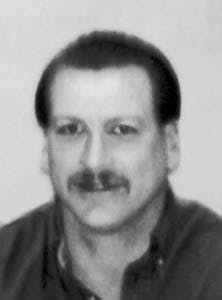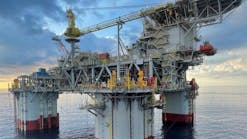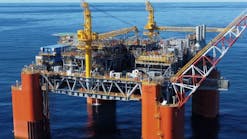Ray N. Walker, Jr.
Union Pacific Resources Co.
Fort Worth, Tex.C.D. Martin
Halliburton Energy Services
Fort Worth, Tex.
A 2-year cost-reduction program cut East Texas gas-well drilling and completion costs by 37%. Figs. 1a and b [19973 bytes] show the chronological trend of the cost reductions.
Union Pacific Resources (UPR) has implemented the lessons learned during this program in UPR branches in operating areas beyond its East Texas unit, where the company's "exploit marginal acreage team" (EMAT) developed its cost-cutting practices.
Impetus for organizing the EMAT was strong because well-development costs in the Cotton Valley (CV) formation in East Texas dictated that a gas well have a probability of producing more than 1.0 bcf gas during its lifetime. UPR held much acreage where wells potentially could only produce between 0.5 and 1.0 bcf; therefore, if UPR could drive costs down, these marginal areas would become economically exploitable.
In 1994, UPR reduced drilling and completion costs by $23 million, and adopted practices proven successful by the EMAT in all of its East Texas areas, including those in areas of traditionally higher productivity.
The time from spudding a well to first gas sales was reduced from 100 to 50 days (Fig. 1c [19973 bytes]).
Lessons learned
The success of the EMAT was due in large part to management support in both UPR and the service company with which UPR formed an alliance. Many paradigms had to be overcome, and resistance to change broken. The mindset of participants on both sides was one of willingness to try practices not fully proven or universally accepted.
The UPR/Halliburton Energy Service alliance built mutual trust to the point that both sides realized that failure of an individual experiment would not reflect negatively on either side. In this atmosphere, more daring procedures were tried. Many of these are now part of UPR's standard operating procedure for drilling and completing gas wells.
The alliance also enabled the dedication of personnel to planning and performing drilling and completion services.
Completion techniques retained
Fluid efficiency tests, composite bridge plugs, low-cost frac fluid, reduction in standby equipment, reduced on site supervision, and sand plugs are techniques UPR will continue to use.
Fluid efficiency tests (FET), run with a minifrac, determined the frac pad volume before proppant was added to the frac fluid, and identified potential problems with perforation efficiency and/or tortuosity.
Composite bridge plugs have saved UPR an average of 4 days/well completion. The quick-drilling bridge plugs isolate zones during multiple-zone fracturing of a well bore. The plugs are made primarily of non-metallic composite materials (epoxy, glass fibers, and ceramics), and one small ferrous-metal spring. Drill-out times are as brief as 30 min/plug.
Because the plugs are consistently set quickly and give positive zonal isolation, stimulation work can be planned with certainty and without built-in waiting time. Composite plug costs are economically comparable to using sand plugs to obtain zonal isolation.
UPR changed to a low-cost guar fluid, crosslinked by zirconate, as its proppant-carrier fluid. The guar-based fluid was thinner, but proved to carry proppant more effectively than the Cmhpg (carboxymethyl hydroxypropyl) fluid formerly used. The low-viscosity frac fluid yielded less frac height and more efficient frac jobs.
Experimentation and optimization processes, fostered by the alliance, have enabled this fluid system to be used by other operators.
Because the service company equipment had demonstrated a low failure rate, UPR reduced backup service equipment stationed on site during completion work. This practice saved costs, and broke many service and operating company paradigms.
Completions are supervised by one representative of the alliance. Before the alliance, both UPR and the service company supplied supervisors. The trust formed between operator and service company allowed this significant change in operating style.
When rising pumping pressures can not be explained or accounted for, UPR uses sand plugs and gel slugs in the pad to:
- Clean-up perforations by erosion
- Erode away tortuosity to make a less resistive path for the pad to follow
- Eliminate multiple fractures
Completion techniques under evaluation
Continuous completion operations, extreme overbalance perforation, and lower pressure wellheads are completion techniques that are still under evaluation.
UPR saved 3.25% on completion costs and produced a well earlier by fracturing all zones in a continuous operation. This method provided better use of service equipment, and needed only one rig-up for treating all zones.
But this completion style was not popular with crews who did not favor fracturing operations during the night. Anticipating a slower pace of drilling in 1996, UPR may not use the 24-hr completion technique again. With equipment more readily available, there is less benefit in compressing all fracture treatments into a continuous operation.
Some wells drilled into the Travis Peak sand do not require fracture stimulation treatments; therefore, extreme overbalance perforation (EOP) has been attempted to remove near well bore damage and open perforations. The value of using EOP in UPR's East Texas wells has not yet been proven. Further study and testing are anticipated.
Because there is a great price difference between wellheads of different ratings, use of a lower-rated wellhead was justified. The disadvantage of a lighter wellhead is that subsequent workovers may be more expensive because extra safety measures may be required.
At about the time UPR switched to 3,000-psi wellhead equipment, the prices of 5,000-psi wellhead equipment were reduced to near 3000-psi equipment prices. But UPR's willingness to try the lighter-duty equipment did save significant costs.
Completion techniques not retained
Before composite plugs were developed, UPR attempted to gain zone isolation between frac stages in tubingless completions with a mechanical collar stop as a landing system for plugs.
This method caused plug sticking and subsequent loss of reserves. This method will not be used by UPR again.
Drilling techniques retained
Customized bits, high-yield cement, closed-loop mud systems, and elimination of open hole logs are techniques that have saved drilling costs.
UPR introduced polycrystalline diamond compact (PDC) bits in East Texas. Often, PDC bits can be re-used, which further reduces cost.
Experiments with various bits has found bits that yield maximum rate of penetration (ROP). UPR has worked with its bit supplier to modify bit design to obtain maximum ROP by matching specific bit designs with specific intervals.
For cementing production casing, UPR pumped high-yield cement slurries instead of the formerly used slurries of premium cement with silica flour. The belief that high compressive strengths were needed for zone isolation during frac jobs was proved wrong, resulting in further savings.
To enable re-use of drilling fluid, UPR uses closed-loop drilling mud systems and state-of-the-art solids-control equipment. Benefits include:
- Mud-cost savings
- Smaller well locations, especially important in wetlands
- Elimination of large reserve pits.
In mature drilling areas with surrounding offset wells and consistent reservoir layering, UPR may decide not run open hole logs and instead replace them with a cased hole gamma-neutron log.
UPR has retained a tubingless completion method; however, this technique will not be profitable in all cases. UPR has run caliper logs in tubingless wells where large frac jobs were pumped and found pitting and corrosion inside the production casing, probably caused by water chlorides and pH imbalance in produced water.
Because these tubingless completion casings are cemented in, no replacement of tubulars is possible.
Also cementing through slimhole tubing has presented some operational problems because of the small-diameter casing precludes cementing with turbulent flow. Drilling mud left behind contaminates cement slurries.
Some slimhole casings have sustained unexplained damage from splitting and collapsing (to oval shape). Damage may have come from multiple fracture jobs and/or perforating.
UPR uses the tubingless completions only when there are one or two target intervals in the well. Cost reductions from tubingless completions have been greater than predicted.
Drilling techniques not retained
Air drilling, aerated muds, and mud motors added to pipe rotations were techniques not retained by UPR.
The one well UPR drilled with air showed good initial penetration, but the excessive influx of water reduced hydrostatic pressure and allowed wet sands to flood the well bore. The attempt was very expensive, and significant drill pipe corrosion damage occurred.
UPR lightened the drilling mud by aerating it in an attempt to increase bit ROP; no improvement was noted. The company also experienced problems with water influx, drill pipe corrosion damage, and mud-property maintenance.
To increase bit rotation speed while drilling with PDC bits, UPR used a mud motor to make bit-rotation speed equal to the sum of rotary table speed and mud motor speed. Two wells were drilled in this manner with no detectable increase in ROP when compared to normal ROP where only rotary table speed turned the drill bit.
The Authors
Ray N. Walker, Jr. is a staff engineer and East Texas team leader for Union Pacific Resources Co. in Fort Worth. He is responsible for development of UPR gas reserves in East Texas. Walker has a BS in agricultural engineering from Texas A&M University. He is a member of SPE and AADE, and is past chairman of the East Texas Gas Producers Association. Walker is a registered professional engineer in Texas.
C.D. Martin is a Halliburton Energy Services technical advisor currently assigned to the UPR/HES alliance in Fort Worth. He has held a variety of engineering and management positions in the petroleum industry. Martin has a BS in agricultural engineering from Texas A&M University. He is a member of SPE and AADE.
Copyright 1996 Oil & Gas Journal. All Rights Reserved.




